|
|
| Übersicht – Contents: | |
Diese Seite ist Teil des Projektes
|
|
| Übersicht – Contents: | |
Flaggen – Flags: |
|
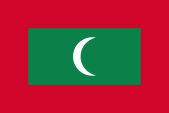 |
National- und Handelsflagge – national flag and merchant flag, Seitenverhältnis – ratio = 2:3, Quelle/Source, nach/by: Flags of the World   |
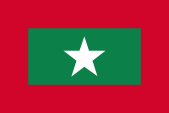 |
angebliche Marineflagge – alleged naval flag, unsicher – uncertain, Seitenverhältnis – ratio = 2:3, Quelle/Source, nach/by: Flags of the World |
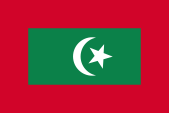 |
seit/since 1968, Flagge des Präsidenten – flag of the President, Seitenverhältnis – ratio = 2:3, Quelle/Source, nach/by: Flags of the World |
historische Flaggen – historical Flags: |
|
 |
19. Jhd./19th century, |
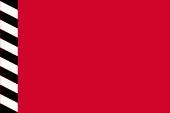 |
1903–1926, |
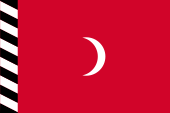 |
1926–1953, Nationalflagge – national flag, Seitenverhältnis – ratio = 2:3, Quelle/Source, nach/by: Wikipedia (EN), Flaggenbuch 1939 |
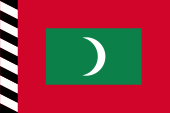 |
1926–1953, Staatsflagge – state flag, Seitenverhältnis – ratio = 2:3, Quelle/Source, nach/by: Wikipedia (EN), Flaggenbuch 1939 |
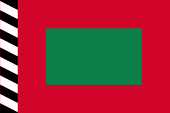 |
1926–1953(?), Handelsflagge – merchant flag, Seitenverhältnis – ratio = 2:3, Quelle/Source, nach/by: Flaggenbuch 1939 |
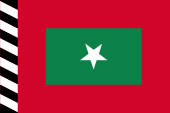 |
1926–1953(?), Seedienstflagge – offshore state flag, Seitenverhältnis – ratio = 2:3, Quelle/Source, nach/by: Flaggenbuch 1939 |
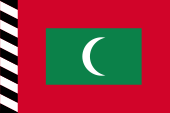 |
1953–1965, National- und Staatsflagge – national and state flag, Seitenverhältnis – ratio = 2:3, Quelle/Source, nach/by: Wikipedia (DE) |
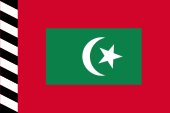 |
1954–1965, Flagge des Sultans – flag of the Sultan, Seitenverhältnis – ratio = 2:3, Quelle/Source, nach/by: Wikipedia (DE) |
 |
1965–1968, Flagge des Sultans – flag of the Sultan, Seitenverhältnis – ratio = 2:3, Quelle/Source, nach/by: Wikipedia (DE) |
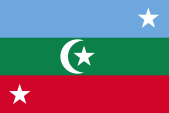 |
1958–1963, Sezession – Secession, Flagge der Republik Suvadiva – flag of the Suvadive Republic, Seitenverhältnis – ratio = 2:3, Quelle/Source, nach/by: Wikipedia (DE) |
| Die National- und Handelsflagge der Malediven zeigt ein rot umrandetes grünes Feld mit einem weißem Halbmond. Sie wurde in ihrer heutigen Form am 25.07.1965 erstmals offiziell gehisst. In die Farben der Flagge werden heute folgende Bedeutungen hineininterpretiert: Rot steht für das Blut der Helden der Nation und ihre Bereitschaft, jeden Tropfen Blut zur Verteidigung ihres Landes zu opfern. Grün steht für Frieden und Wohlstand und der Mond für den Islam, der auf den Malediven Staatsreligion ist. Die Farben der Flagge werden folgendermaßen angegeben: Rot = Pantone 186, Grün = Pantone 348. | The national and merchant flag of the Maldives shows a red bordered green field with a white crescent. It was officially hoisted in its today's design on 25th of July in 1965 for the first time. Today, the following meanings are interpreted into the colours of the flag: Red stands for the blood of the nation's heroes and their willingness to sacrifice every drop of blood to defend their country. Green stands for peace and prosperity and the moon for Islam, which is the state religion in the Maldives. The colours of the flag are indicated as follows: Red = Pantone 186, Green = Pantone 348. |
| Die ursprüngliche Flagge der Inseln war ein einfarbiges rotes Tuch, wie es rings um den Indischen Ozean bei vielen Staaten als Nationalflagge weit verbreitet war. Auch unter dem britischen Protektorat wurde diese Flagge beibehalten. Zu Beginn des 20. Jahrhunderts begann man die Flagge am Mast um einen 13-fach schräg schwarz-weiß gestreiften Streifen zu ergänzen. Er wurde "Dhandimathi" genannt. Die schwarzen und weißen Streifen standen für die 13 Inselgruppen aus denen die Malediven bestehen. Zwischen 1926 und 1932 wurde dann noch der weiße Halbmond in der Mitte der Flagge ergänzt, wobei die beiden Enden des Halbmondes in Richtung des Flaggenmasts zeigten. | The original flag of the islands was a single-coloured red
cloth how it was wide spread as national flag in many countries around the
Indian Ocean. Even under the British protectorate was this flag continued. At the beginning of the 20th century, a 13-way diagonal black and white stripe began to be added to the flag at the mast. It was called "Dhandimathi". The black and white stripes stood for the 13 archipelagos the Maldives consist off. Between 1926 and 1932, the white crescent was then added to the centre of the flag, however, the two ends of the crescent pointed towards the flagpole. |
| Amir Abdul Majid Didi, er war zwischen 1926 und 1932 Premierminister des Landes, initiierte während seiner Amtszeit eine wesentliche Veränderung auf der Flagge: Er ließ das grüne Feld in der Mitte der Flaggen des Landes ergänzen. Die Malediven wurden als britische Kolonie von Ceylon (heute Sri Lanka) aus verwaltet. Als Ceylon 1949 unabhängig wurde verblieben die Malediven unter britischer Verwaltung und im Jahre 1953 eine republikanische Verfassung angenommen. Das machte sich auch auf der Staatsflagge bemerkbar – die ab jetzt auch als Nationalflagge verwendet werden durfte – denn der Mond wurde gedreht, die beiden Enden des Halbmondes zeigten von nun ab in Richtung des wehenden Endes der Flagge. Der Sultan wurde 1954 wieder eingesetzt, die Flaggen blieben unverändert. Die Malediven wurden 1965 von Großbritannien unabhängig, zu diesem Anlass wurde der schwarz-weiße Dhandimathi-Streifen von allen Flaggen entfernt. |
Amir Abdul Majid Didi, who was the country's prime minister between 1926 and
1932, initiated a major change on the flag during his tenure: he had added
the green field to the centre of the country's flags. The Maldives was
administered as a British colony from Ceylon (now Sri Lanka). When Ceylon became independent in 1949, the Maldives remained under British administration and a republican constitution was adopted in 1953. This was also reflected in the state flag – which could now also be used as the national flag – because the moon was rotated, with the two ends of the crescent pointing towards the waving end of the flag. The Sultan was reinstated in 1954, the flags remained unchanged. The Maldives became independent from Great Britain in 1965, on this occasion the black and white Dhandimathi stripe was removed from all flags. |
| Rot ist im Bereich des Indischen Ozeans eine Flaggenfarbe mit großer Tradition und großer Verbreitung, von den Küsten Arabiens, über Sansibar bis zu den Maldiven, die in engem Zusammenhang zum Islam steht. Rote Flaggen haben bzw. hatten alle islamischen Dynastien, die sich auf die Herkunft von den Alawiten (auch Aliden genannt, Abkömmlinge Ali's) berufen (z.B. heute noch Marokko, ehemals Nordjemen), oder auch die arabischen Emirate, einschließlich Omans. Oman hatte früher, bis etwa 1730 auch die gesamte afrikanische Ostküste unterworfen (bis weit ins heutige Mosambik hinein), und durch Verlegung des Regierungssitzes nach Sansibar (ca. 1830) ein neues Reich (Sansibar) begründet, welches auch dessen rote Flagge führte. |
Red is in the region of the Indian Ocean a flag color with a great tradition
and wide dissemination, from the coasts of Arabia, over Zansibar to the
Maldives, which stands in dense context to the islam. Red flags had and have all islamic dynasties, which come from the Alawites (Alides, descentants of Ali) like today Morokko or former North Yemen, the Arabian Emirates and Oman. Oman incorporated till 1730 the african eastern coast, to an in the today Mocambique. They moved their capital to Zansibar (ca. 1830) and founded a new empire which had its red flag, too. |
| Quelle/Source: Die Welt der Flaggen, Die Welt im bunten Flaggenbild, Volker Preuß, Wikipedia (EN) | |
Wappen – Coat of Arms: |
|
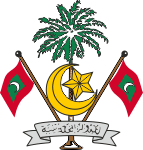 |
Wappen der Malediven – coat of arms of Maldives, Quelle/Source: Corel Draw 4 |
| Das Staatswappen der Malediven zeigt einem Halbmond mit Stern vor einer Palme, zwischen zwei Nationalflaggen. Darunter ein Schriftband mit der arabischen Inschrift »AI-Daulat al Mahldibiah«. Die Palme symbolisiert die Natur des Landes, der Halbmond und der Stern stehen für den Islam als die Staatsreligion. Das Wappen wurde zuletzt in den 90-er Jahren geändert, als Halbmond und Stern von Silber auf Gold umgefärbt wurden. | The coat
of arms of the Maldives shows a crescent with star in front of a palm tree
between two national flags. Below a banner with the Arabic inscription
»AI-Daulat al Mahldibiah«.
The palm tree symbolizes the nature of the country, the crescent and the
star the Islamic state's religion. The coat of arms was last changed in the 1990s, when the crescent and star were changed from silver to gold. |
| Quelle/Source: Flaggen Wappen Hymnen, Wikipedia (DE) | |
Flugzeugkokarde – aircraft roundel: |
|
 |
Flugzeugkokarde – aircraft roundel Quelle/Source, nach/by: Wikipedia (EN) |
Landkarte – Map: |
Lage – Position: |
Landkarte des Landes – Map of the Country: |
|
|
| Zahlen und Fakten – Numbers and Facts: | |
|
|
|
|
|
|
|
|
|
|
|
|
|
|
|
|
|
|
|
|
|
| 2. Jhd. ·
Besiedelung duch Singhalesen aus Indien 12. Jhd. · Einwanderung von Arabern und Persern → beginnende Islamisierung 1153 · der Islam wird Staatsreligion ca. 1150 · Gründung des Sultanats 1512 · Entdeckung durch portugiesische Seefahrer 1518 · portugiesischer Eroberungsversuch, der König von Kandy (Ceylon) übernimmt die Schutzherrschaft über das Land 1558 · Eroberung durch Portugal 1573 · die Portugiesen verlassen die Inseln 1645 · Errichtung des niederländischen Protektorats von Niederländisch-Ceylon aus 1796 · durch die Errichtung der britischen Herrschaft auf Ceylon kommen die Malediven fromell von den Niederlanden an Großbritannien 1887 · Errichtung des britischen Protektorats 1932 · erste Verfassung 1948 · duch die Unabhängigkeit Ceylons erfolgt die administrative Trennung von Ceylon 1952 · innere Autonomie 1953 · Proklamation der Republik 1954 · Wiedereinsetzung des Sultans 1959–1963 · separatistische Abspalung der "Republik Suvadiva" auf den drei südlichen Atollen der Malediven 1960 · Errichtung eines britischen Luftwaffenstützpunktes auf der Insel Gan 26.07.1965 · Unabhängigkeit, die Malediven werden Mitglied des Commonwealth of Nations 11.11.1968 · Abschaffung des Sultanats und Proklamation der Republik 1975 · Abzug der britischen Truppen von der Insel Gan 1988 · Putschversuch tamilischer Söldner 1989 · Abzug der 1988 ins Land gerufenen indischen Truppen 2003 · Massendemonstrationen, Unruhen 2004 · Ausnahmezustand 2012 · Massendemonstrationen, Unruhen 2016 · die Malediven verlassen den Commonwealth of Nations 2020 · Wiedereintritt in den Commonwealth of Nations |
| 2nd cent.
· settlement by Singhalese from India 12th cent. · immigration of Arabs and Persians → beginning islamization 1153 · the Islam becomes state's religion ca. 1150 · foundation of the sultanate 1512 · discovery by Portugese seafarers 1518 · Portugese attempt of conquest, the King of Candy (Ceylon) assumes the protectorate over the country 1558 · conquest by Portugal 1573 · the Portugese leave the islands 1645 · establishment of Netherlands protectorate out of Netherlands Ceylon 1796 · by the establishment of the British rule on Ceylon the Maledives come formally from the Netherlands to United Kingdom 1887 · establishment of the British protectorate 1932 · first constitution 1948 · because of the independence of Ceylon results the administrative separation from Ceylon 1952 · internal autonomy 1953 · proclamation of the republic 1954 · reinstatement of the Sultan 1959–1963 · Separatist secession of the "Suvadive Republic" on the three southern atolls of the Maldives 1960 · establishment of a British Air Force base on Gan Island 26th of July 1965 · independence, the Maldives become a member of the Commonwealth of Nations 11th of November 1968 · abolition of the sultanate and proclamation of the republic 1975 · withdrawal of the British troops from Gan Island 1988 · attempted coup d'état by Tamil mercenaries 1989 · withdrawal of the in 1988 into the country beged Indian troops 2003 · Mass demonstrations, riots 2004 · state of emergency 2012 · Mass demonstrations, riots 2016 · the Maldives leave the Commonwealth of Nations 2020 · the Maldives rejoin the Commonwealth of Nations |
| Quelle/Source: Atlas zur Geschichte, Wikipedia (D), Discovery '97, World Statesmen |
| Der Begriff "Malediven" ist wahrscheinlich durch Europäisierung des Namens "AI-Daulat al Mahldibiah" entstanden. Dieser arabische Begriff heißt übersetzt: "Staat der Inseln vor der Malabarküste". Die offizielle Eigenbezeichnung des Landes lautet jedoch "Divehi Rajje" → "Maledivische Republik". | The logos "Maldives" is probably formed by europeization of the name "AI-Daulat al Mahldibiah". That Arabic words mean in translation: "State of the Islands in front of the Malabar Coast". But the official self-denomination of the country is "Divehi Rajje" → "Maledivian Republic". |
| Quelle/Source: Handbuch der geographischen Namen, Volker Preuß | |